After months of preparation, numerous blog posts, and massive anticipation, the ST Developers Conference took place yesterday in Santa Clara, California, and the excitement was palpable. With a lot more demos, booths, and presentations than last year, professionals and enthusiasts across a broad range of industries got to see innovations, learn about new technologies, and receive specialized training. Thanks to fascinating hands-on sessions, attendees learned how to develop IoT cloud applications for Azure and AWS using an STM32 development board. They also had a very impressive walkthrough on Secure Boot and Firmware Update, and there was even a lab on SensorTile, which is almost poetic.
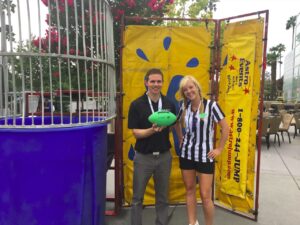
This time last year, at the ST Developers Conference 2016, SensorTile was just introduced to attendees through a presentation and a couple of projects. Yesterday, the world’s densest sensor board was in so many products, and the hands-on session was so popular, it was an impressive testament to the journey traveled by ST in just a year.
For instance, Vensi was showcasing a football that had a SensorTile module in its core. Powered by a battery, and transmitting information to an application from Avnet using the Bluetooth transceiver, it was able to track a myriad of data from velocity to spiral efficiency, and even record the surrounding noises thanks to its microphone, all this by only using the algorithms provided freely in the ST Function Packs. Hence, the aptly named “Superball” was the star of the conference, and the fact that Vensi and Avnet had placed a dunk tank so the best throwers could send someone swimming was clearly a hit.
ST Developers Conference: A Different Perspective on IoT
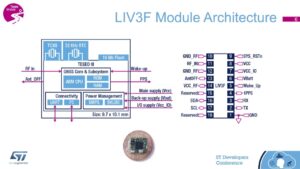
IoT (Internet of Things) was also at the center of many presentations. On top of the traditional sessions everyone expects, such as those delving into LoRa and SigFox, other presenters tackled the issue from a different perspective. For instance, a session showed how connected devices could take advantage of the Teseo LIV3F, a very small (9.7 mm x 10.1 mm) multi-constellation GNSS (Global Navigation Satellite System) module that includes a 16 Mbit Flash to allow for data logging (12 hours of data at 1 Hz). Fast and precise thanks to its 26 MHz Temperature Compensated Crystal Oscillator (TCXO), which gives it a serious advantage over chips that just use crystals, it can even predict its position for up to 6 days if the satellite signal and connection to the Internet is no longer available.
There were also practical presentations to ensure every attendee left with substantial knowledge and a desire to try what they had discussed the previous day. For instance, IBM detailed in a fascinating presentation how to transform the data outputted by a SensorTile into “Insights” by using its cloud services and data science applications, which are most often free to try and suitable for all users, whether they are just passionate or working in a big corporation. This presentation even showed how it was possible to use machine learning to completely change our relation to the data collected.
Taming the Internet of Terrors
Similarly, the talk Platform-Level Security IoT Devices dug extensively, and in a very pragmatic way, into what it takes to truly secure an IoT platform, whether it is at the silicon or the code level. Attendees got to better understand the features offered by ARM and those unique to ST systems, as well as important concepts like Readout Protection Levels (RDP), and Proprietary Code Read Out Protection (PCROP), and how to best view them in the context of an application.
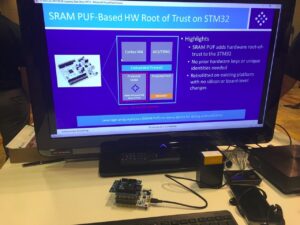
However, ST was not alone in ensuring the Internet of Things doesn’t become the Internet of Threats. Two companies belonging to the new ST Partner Program that really impressed attendees were Intrinsic ID and GlobalSign, which were demonstrating together the PUF (Physically Unclonable Function). The technology uses the natural arrangements of the bits in the SRAM to generate a unique and completely private key.
The system is brilliant because there’s no memory cell storing the data that makes up the key, so there’s no risk of copy or imitation. The system simply uses the fingerprint of the SRAM to generate a private and public key, the latter enabling a certificate that could serve as authentication for a cloud service, for instance. Intrinsic ID and GlobalSign have developed solutions for different STM32 platforms and provide documentation and services ensuring that the implementation of their system by the application developers remains optimal and according to best practices.
You Had to Be There…
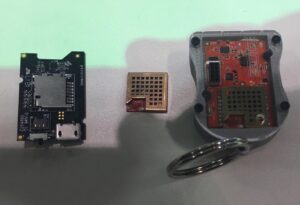
There were many more ST partners that shined during the Developers Conference. For instance, Samtec was showcasing a shielded SensorTile module that had already passed FCC and CE certifications, meaning that engineers could greatly simplify their design process and reduce their time to market. Another example was Electric Imp, which was putting forward a secure IoT platform running their own operating system on STM32 microcontrollers (MCU) to ensure applications run in their virtual machine and communicate with their agent in the cloud. Hence, it was truly remarkable to see all the partners come together, so attendees looking to create the next big IoT device just had to pick the building blocks laid out on the show floor.
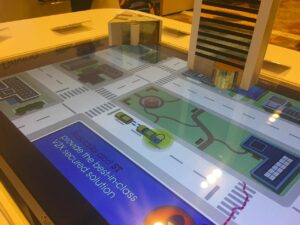
ST also had many more presentations and demos on a broad range of topics. People got to see dynamic NFC tags, an animated presentation on the impact of V2X communications, and they also received practical guidelines on how to optimize STM32L4 systems by adjusting the clock tree or use an external SMPS (Switched-Mode Power Supply). There were also presentations on the different MCUs and sensors dedicated to the automotive industry and how they’ve been making autonomous driving a reality.There was even a great VR demo and a booth on high-performing STM32 MCUs, just to name a few.
In the end, words don’t truly do justice to how impactful the Developers Conference was to all the participants. Hence, there’s only one thing left to say to those who did attend and those who couldn’t: see you next year on September 5, 2018, for the next ST Developers Conference, or maybe before, during one of our Technology Tours.
